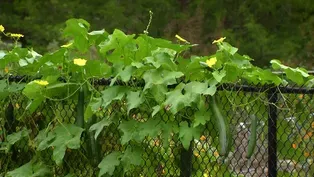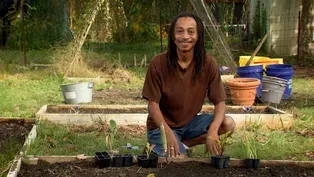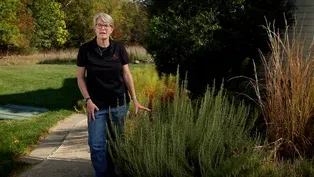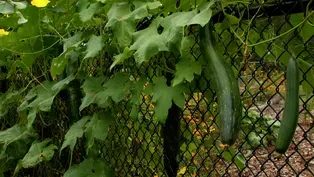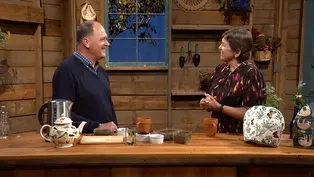Virginia Home Grown
Tea Garden
Clip: Season 23 Episode 8 | 7m 33sVideo has Closed Captions
Tour an herb garden focused on tea plants!
Peggy Singlemann visits Mark Ragland in his tea garden in Prince George County to discuss how to grow the tea tree, Camellia sinensis, in Virginia, as well as herbs for blending with tea. Featured on VHG episode 2308; October 2023.
Problems with Closed Captions? Closed Captioning Feedback
Problems with Closed Captions? Closed Captioning Feedback
Virginia Home Grown is a local public television program presented by VPM
Virginia Home Grown
Tea Garden
Clip: Season 23 Episode 8 | 7m 33sVideo has Closed Captions
Peggy Singlemann visits Mark Ragland in his tea garden in Prince George County to discuss how to grow the tea tree, Camellia sinensis, in Virginia, as well as herbs for blending with tea. Featured on VHG episode 2308; October 2023.
Problems with Closed Captions? Closed Captioning Feedback
How to Watch Virginia Home Grown
Virginia Home Grown is available to stream on pbs.org and the free PBS App, available on iPhone, Apple TV, Android TV, Android smartphones, Amazon Fire TV, Amazon Fire Tablet, Roku, Samsung Smart TV, and Vizio.
Providing Support for PBS.org
Learn Moreabout PBS online sponsorship>>Peggy, welcome back to my garden.
>>Mark, it's been so long since I've been here and look how much everything's grown.
>>Everything's really gotten big.
>>It's amazing.
These crepe myrtles were just eight feet tall last time I was here.
>>I know, it's changed the garden.
It's become a primary shade garden where we used to be full sun.
>>Yes, you've had to totally change your plant inventory.
>>And still replanting as we speak and that'll be going on for a while.
>>Wow.
With so many different garden rooms which one is your favorite?
>>Ah, it's always hard to pick favorites, but I have to say herbs would probably be it.
>>Yes.
>>And, of course, tea is one of those.
>>Oh, and look at these cute little guys.
>>Yeah, these are the new plantings, the new varieties, but come look at the mature specimen over here.
>>Okay.
Oh, Mark, this is absolutely gorgeous.
And look at all those flower buds.
And look at all those flowers.
It is fall and it is a fall blooming camellia.
So what type of camellia is this?
>>This is a camellia sinensis.
And that's important to know the variety because you wouldn't wanna make tea out of another variety of camellia.
>>Oh, gosh, no, I can imagine, yes.
This is such a beautiful plant.
How do you get it to survive here?
>>There's a few things you have to do to check the boxes and make sure it's happy.
First, we get easily, the acidic soil is a necessary thing for this plant.
The other thing is water.
So we do get a lot of rain, but sometimes we don't.
And when we don't you gotta make sure and keep this wet feet.
>>Okay.
>>The third thing is winter warmth.
So I always tell people, when you're out in the garden in the winter, watch where the snow melts first, that's your warm spot.
And that's true for right here.
Plus I get the reflective heat from the gravel, the stonework in the building.
And it's all protecting this and keeping it nice and happy through the colder parts of our winters.
>>People don't realize the value of a microclimate, the reflection off of a wall, a stone, or even a walkway plus their driveway.
It just makes such a difference.
>>It's so true.
I mean, you'll have so many in your yard depending on the size of your garden.
>>Exactly, but do you have to fertilize this at all?
>>I don't.
You can fertilize it.
And sometimes I'll add compost to the top just to dress it, but generally speaking, it's perfectly happy in our soil.
>>That's fantastic.
Well, let's get back to tea, though.
What part of this tea camellia do you use to make tea?
>>So I picked a branch, I'll take this out.
So typically when tea pickers are picking they're going for just the newest leaves, the tender leaves.
You can use any of the leaves, but the reality is the best flavors are gonna be in that new growth.
These older ones at the bottom they're just a little tannic.
They've got too much of the things you don't want in your teacup.
>>Understandable.
Well, I'm gonna ask then.
You know, we have buds here.
Does this make a different tea the bud of the plant rather than the leaves of the plant?
>>So that's the amazing part.
There's so many different types of teas and people are always wondering do I grow this plant for white tea, and this plant for green tea?
And the reality is you can make all varieties of tea from the same leaf.
It's when you pick it and how you process it.
>>So when's the best time to pick tea?
>>Well, that depends on who you are.
There are people that swear by that first picking in the spring, that first flush of new growth 'cause you've got all that wonderful flavor building up all winter long and it's gonna be right in the tip.
So your first spring picking, which is called first flush, is typically your best.
>>Does that make the green tea, or what type of tea does that make typically?
>>You can make any of the teas.
White teas usually come out then 'cause that's when you're getting all these wonderful new, and the white tea is gonna be that newest little bud of growth.
>>A tiny little thing.
>>It's a little fuzzy.
And it's got a white fuzz to it which is why it's called white tea.
>>Interesting.
So black tea and green tea.
What parts of the leaf are they made out of?
>>Same leaf.
>>Okay.
>>The difference is, if I take this leaf now I've picked it it's gonna start to die.
It's a process, right?
And just like when you cut an apple, it starts to oxidize.
Tea leaves do the same thing.
So we're gonna cut this up in lots of little pieces.
And then as it oxidizes, we're counting.
As soon as it starts to oxidize you're getting away from green tea.
So you don't want it to oxidize if you want green tea.
Once it starts oxidizing, oh, then it could be in a yellow tea, I'll stop it.
No, no, we'll let it go halfway through its full process.
That's oolong.
And if it goes all the way, then we get the black tea.
>>Interesting.
So how do you stop the oxidation?
>>You need to heat it.
Heat it in some way.
And there's another great variance in the varieties of teas, right?
If you heat it with smoke, if you heat it in the oven, if you heat it in the sun.
>>So this whole plant here, we can get every type of tea we want.
A type of black tea I'll say.
>>Exactly.
When I've made tea from this myself, I like oolong.
So it's half fermented.
So I'll pick this, cut it up, and I'll let it go for just a few hours instead of a whole day.
And then I put it in the oven to stop it.
And it makes a really nice oolong.
>>So what other plants can be used to make tea with?
>>Well, let's be clear on one point.
To be true tea it needs to be camellia sinensis, but it's a modern world.
So a lot of people still call teas herbs, and things that are infused with herbs.
So we should probably go into the herb garden and look at the herbs that are growing for that.
>>Sounds great.
>>Come with me, come on.
>>Okay.
>>So this is the formal herb garden.
>>This is amazing, Mark.
I love how you've arranged the beds.
>>Well, thank you.
It's divided into different types of herbs based on their classifications.
>>Wow, how many different herbs do you have in here?
>>Usually around 200 different varieties.
>>My, my, I'm really impressed by this.
>>Thank you.
>>And I really love the fact that you've got the tea plants together.
>>So this is my OCD nature coming out.
I've got all the herbs organized by types here, the salvias, but these are the herbs for tea.
>>Ah, what a wide variety, so many different types.
>>Well, there are a lot of different types.
>>Yes.
You know, people don't realize or associate tea with grass.
>>You wouldn't normally, but this particular one is quite lemony.
Lemongrass is excellent for tea, whether it's its own brew, or you blend it with the tea for the lemon flavor.
>>A lot of people don't know that that's an annual.
>>Well, it is an annual here.
>>Yes.
>>And if we get lucky I've had it come through a couple winters.
>>Oh, wonderful.
>>So sometimes, yes, but count on replacing it.
>>Yeah.
What other lemony things do you have in here?
>>Well, there are some good herbs for that.
Lemon verbena is my personal favorite.
>>Mine too, it's so lemony.
>>It does have that great lemon flavor.
>>Yes.
>>And then there's lemon balm.
>>Oh, which we have to be careful about.
>>I saw the cringe.
Yeah, it is a little invasive.
So you wanna get those seed heads off before it gets into other areas you don't want it, but super hardy that's the good news.
>>It is, it is, but you also have another tall plant there, the hibiscus.
>>Right, my love of Egypt and hibiscus tea as a welcome drink.
>>Oh really?
>>I had to have hibiscus in the garden.
It makes a wonderful, wonderful tea all to itself, but it does blend well with tea.
>>It does.
I can't think of a better way to welcome people.
>>Yeah, exactly.
>>Oh, how sweet, yes.
Some of the other plants you have.
I'm seeing some bee balm here.
>>Yep, got the bee balm.
We also have the mints all mixed in.
As well as betony and the alpine strawberries for that tea.
>>Wonderful strawberry flavor.
>>Yes.
>>And I think people need to realize, I put my mints in a pot so that they don't wander.
>>Yes.
They're in their own little rock fortress here.
Not that they can't escape a little but I get 'em when they come out.
>>Good job.
Well, throughout the garden, what other plants do you have?
>>Well, they're spread all out, right?
So there's more.
The chamomile is over in this bed.
We've got basil here and the basil is going to bloom now because I need to help those poor pollinators at the end of the season, but I'll cut that back and get to the pesto very soon.
>>Excellent, excellent.
You know, Mark, I also know that you had some lavender in the corner too, and I love lavender tea.
>>Well, there's my favorite too.
Blending lavender with tea just makes that wonderful soothing blend, right?
You've got that tea that's calming you and then the lavender does that.
>>Ah, it's just such a- >>Perfect place to be.
>>Exactly, speaking of perfect places to be this is a perfect place to be.
And I just wanna thank you so much for having us.
>>Oh, I'm so glad you got to come back out.
You've been a longtime friend.
It's good to have you in the garden again.
>>Thank you, it's so nice to be here.
>>In fact, I should probably welcome you to a cup of tea.
Why don't we go get one now?
>>I love it, let's go.
>>Okay.
Video has Closed Captions
Learn how to grow tea trees and luffa plants! (26m 46s)
Video has Closed Captions
Add interest to landscape beds by using herbs (2m 44s)
Video has Closed Captions
Discover how luffa plants are grown to make natural sponges! (7m 34s)
Natural Sponges made from Luffa
Video has Closed Captions
Learn how the luffa plant is processed to make a sponge (6m 34s)
Providing Support for PBS.org
Learn Moreabout PBS online sponsorshipSupport for PBS provided by:
Virginia Home Grown is a local public television program presented by VPM
